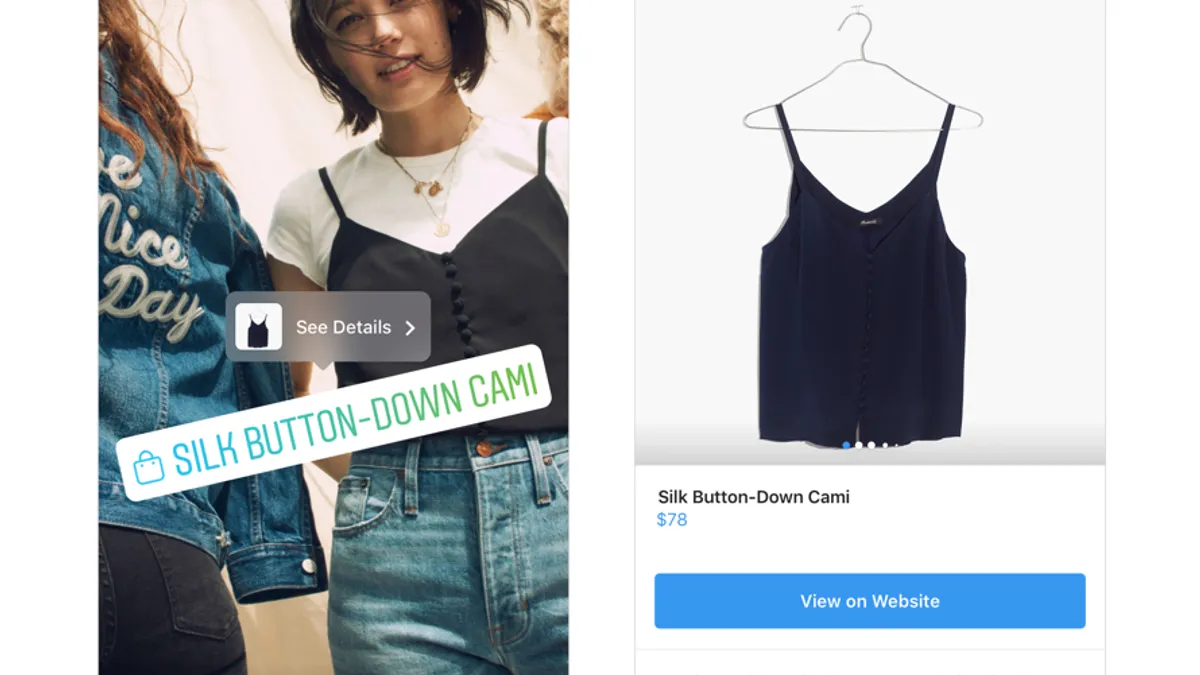Brief:
- Instagram added two shopping features to let people more easily buy products that brands and social influencers show on the image-messaging app, which has about 1 billion mobile users worldwide, the Facebook-owned company announced on Monday.
- The app added shopping to Stories, which strings together multiple images in a single post, after first testing the service in June. Shopping in Stories is now available to businesses in 46 countries. Instagram next week will also roll out a shopping feature in Explore, a section that serves users personalized posts and accounts based on their interests.
- Brands and retailers can use the shopping features to let followers buy items directly. Shopify, which has more than 500,000 merchants, and BigCommerce are among the platforms that are helping e-tailers expand their offerings to Instagram's shopping features, a Shopify blog post announced.
Insight:
Instagram's newest shopping features help to close the loop between product discovery and direct transactions among the app's more than 90 million users who tap specially tagged photos to see product information on shoppable posts. Mobile marketers can still control the direct relationship with their customers because those interactive posts still point to merchant websites for payments and shipping. This helps merchants provide a more seamless experience for customers who see products on social media, eliminating the need for them to search a retailer's website for the desired product and make a purchase.
More than 400 million people use the Stories feature every day, up from 250 million last year, to follow their favorite accounts, according to Instagram, unlocking a large customer base for merchants who use the new Shopping in Stories feature. As users become increasingly familiar with Stories, their completion rate — and potentially conversion rate — may also grow for brands. The average completion rate for brand Stories this year rose 8 percentage points to 72%, possibly indicating that Instagram users closely follow the brands they care about, Digiday reported. To further drive sales, marketers should add a call-to-action button on the last page of a Story, social analytics firm Delmondo suggests.
Retailers also need to be mindful that they don't grow too dependent on Instagram as a shopping platform, and should work to develop direct relationships with customers who bookmark their websites or sign up for notifications, as TechCrunch warns. Instagram can tweak its algorithms to adjust what users see, potentially shutting off sources of revenue for brands who sell on the platform. The publishing industry had a similar experience as Instagram's parent company Facebook adjusted its news feed algorithms to emphasize user posts over third-party content to improve the user experience, causing some publishers to lost significant ad revenue.
Instagram's new shopping features pin the app more directly against other platforms like Pinterest and Wish that also host shoppable posts. The social media app is reportedly developing a standalone shopping app, unnamed sources told The Verge earlier this month, but the company has yet to confirm. Facebook's COO Sheryl Sandberg said during the company's most recent earnings call that more than 25 million businesses have Instagram accounts and 2 million of those purchase ads, creating a fertile audience for potential e-commerce growth.
More shopping features could also help Instagram gather more data about its audience and reach them when they've indicated that they're in the mood to shop. That strategy underpins Amazon's effort to boost its advertising sales as people search through its online store for specific products they need, per The New York Times. As Amazon has shown, e-commerce helps to collect rich data about consumers that's more detailed than what can be gleaned from imprecise algorithms that try to predict where ads appear and catch users as they scroll through a content feed.















